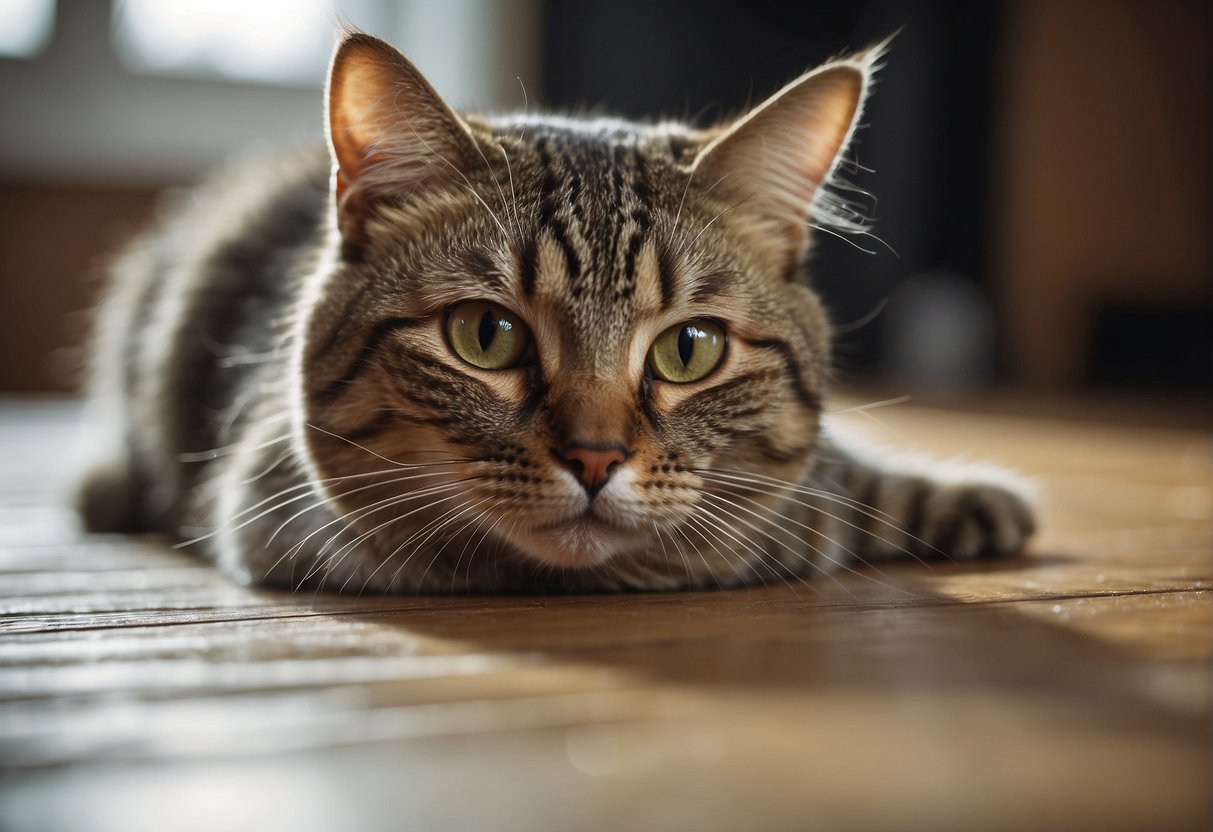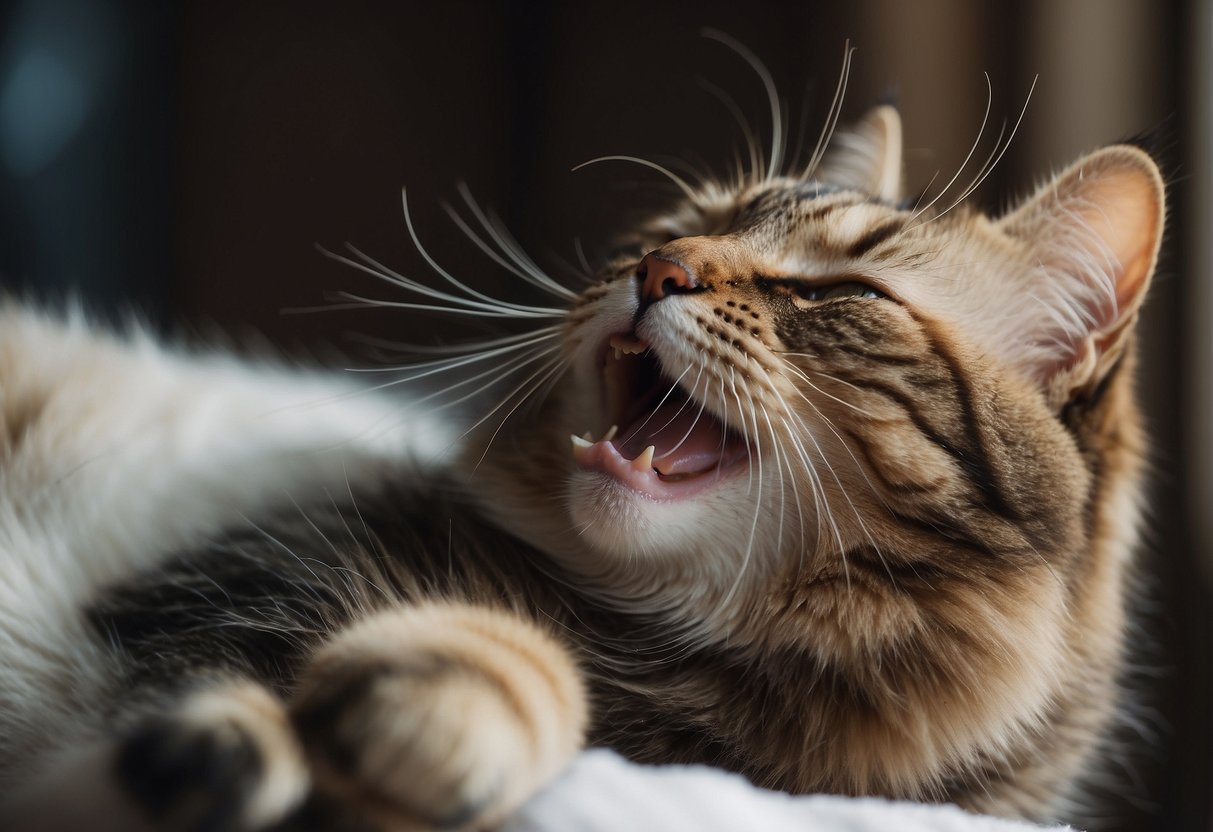Cats get hairballs primarily because they are meticulous groomers. During grooming, their tongues, which are covered in tiny, hook-like structures, snag loose and dead hair. This fur is then swallowed by your cat and usually passes through the digestive system without issue.
However, sometimes the hair accumulates in the stomach and forms a hairball, which is usually regurgitated.

You might notice your cat hacking or gagging as they try to expel a hairball. It’s a common scenario for cat owners to witness: your cat hunched over, making unsettling retching noises followed by the somewhat alarming sight of a wet clump of fur.
While this can seem distressing, it’s often a normal part of their self-cleaning process.
Maintaining your cat’s coat through regular brushing can help minimize hair ingestion and thus hairball formation, especially in long-haired breeds like Persians or Maine Coons. By staying engaged in your cat’s grooming routine, you play a key role in managing this aspect of their health.
Remember, if hairballs occur more frequently than once a week, it’s advisable to consult your vet, as it could be a sign of an underlying issue.
Hairballs in Cats
As a cat owner, you might often find your furry companion dealing with hairballs. It’s a natural, albeit slightly unpleasant, part of their grooming process. Knowing what causes hairballs and recognizing their symptoms can greatly enhance your ability to care for your cat.
Causes of Hairball Formation
The main cause of hairball formation in cats lies in their grooming habits. Your cat’s tongue is covered in tiny, hook-like structures that capture loose fur, which they then swallow. Unlike other items your cat may ingest, fur is not digestibleand can accumulate in their gastrointestinal tract.
Over time, this undigested hair can form a hairball. Typically, the digestive tract will move the majority of the swallowed hair through the system, ultimately expelling it in the feces. However, when fur gathers into a clump, it becomes too large to pass through the intestines and must be expelled by vomiting.
- Grooming: Cats spend a significant portion of their day grooming, which increases the chance of hair ingestion.
- Digestibility: Hair is composed mainly of keratin, which is not broken down by digestion.

Symptoms of Hairballs in Cats
Hairballs can present several noticeable symptoms. Coughing, retching, and gagging are common signs that your cat may be trying to expel a hairball. Vomiting may follow, sometimes with the hairball included in the vomit material.
If you notice these behaviors, it’s generally not a cause for immediate concern, as hairballs are a common occurrence in cats. However, frequent instances or difficulty in expelling a hairball can indicate a need for a vet visit.
Prolonged vomiting, lethargy, or a decrease in appetite could signal a blockage or other serious issues within the gastrointestinal tract.
- Behavioral Signs: Watch for gagging or hacking that may indicate your cat is struggling with a hairball.
- Vomiting: Expelling a hairball typically involves a distinctive form of vomiting.
Preventing and Managing Hairballs
Hairballs don’t have to be a regular nuisance for your feline friends. With a mix of proper grooming techniques and dietary adjustments, you can help minimize these uncomfortable occurrences.
Grooming Techniques
Regular brushing is your first line of defense against hairballs. Brushing not only reduces the amount of hair your cat ingests during self-grooming but also helps distribute natural skin oils throughout their coat, which can keep fur smooth and less likely to mat.
Different cat breeds might need different grooming tools, so if you have a long-haired breed like a Persian, you’ll want to use a comb that can handle their luxurious fur. For short-haired breeds, a bristle brush or rubber grooming mitt can work well to remove loose hair.
- Short-Haired Cats: Brush a few times a week.
- Long-Haired Cats: Brush daily.
Don’t forget to make grooming a positive experience. Start slow, be gentle, and maybe offer a treat afterward so your kitty begins to associate brushing with good things.
Dietary Adjustments
Modifying your cat’s diet can play a crucial role in hairball prevention. A diet rich in fiber can improve your cat’s digestion and help hair pass through the digestive system with more ease. Look for commercial cat foods that are designed for hairball control, as these often have increased fiber content.
- Fiber-rich food: Promotes a healthier gut.
- Special Formulas: Foods marked for hairball care.
Incorporating a little bit of a lubricant, such as a commercial hairball paste, can also help. These products are designed to help hairballs pass through the digestive system rather than accumulating. However, they should be used conservatively and as directed, since overuse can interfere with nutrient absorption.
If you’re unsure about which food or lubricant to use, or if you’re considering a laxative for persistent hairballs, consult with your veterinarian. They can recommend specific products or diets that are suited to your cat’s individual health needs and preferences.
Treatment Options for Hairballs
Managing your cat’s hairballs is crucial for their comfort and health. Let’s explore the effective ways you can help your furry friend.
When to See a Veterinarian
If your cat is frequently hacking up hairballs or showing signs of distress such as chronic vomiting, coughing, or gagging without producing a hairball, it’s time to consult with a veterinarian. These symptoms can indicate underlying issues that may require professional treatment.
In some cases, if hairballs are causing a blockage, surgery may be necessary, but this is typically a last resort. Veterinary care is essential to diagnose and treat any severe complications arising from hairballs.
Home Remedies and Over-the-Counter Solutions
- Regular Grooming: By regularly brushing your cat, you can significantly reduce the amount of hair they ingest during self-grooming. Long-haired breeds might need daily brushing, while short-haired cats can often get by with weekly sessions.
- Hairball Formulas: There are special cat foods designed to prevent hairballs which can aid in digestion and help hair pass through the gastrointestinal tract.
- Laxatives: Products like Laxatone can be given to your cat to help ease hairball passage. These are palatable gels that act as a lubricant to help hairballs move through the intestines.
- Fiber Supplements: Adding fiber to your cat’s diet can help with the digestive process. Pumpkin, for example, is a natural source of fiber that many cats enjoy.
Home remedies and over-the-counter solutions are generally a good first line of defense against hairballs.

My name is James, and welcome to FAQCats!
Along with our team of cat owners, expert pet enthusiasts, and pet professionals, we aim to write engaging helpful, engaging content about cats. At FAQCats we strive to provide content that’s accurate and fun to read. Our team writes about everything related to cats; even the most complex of topics. Through extensive research and caring for our own fur-pals, we’re able to provide something cat owners worldwide will love. Have a look around, and leave us feedback anytime!

